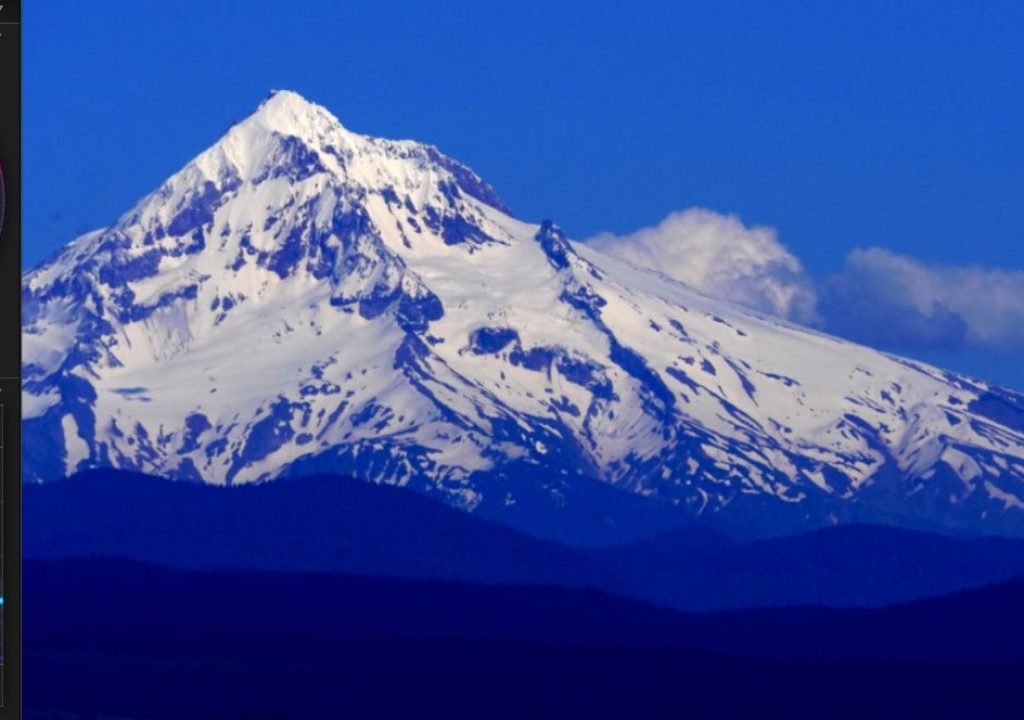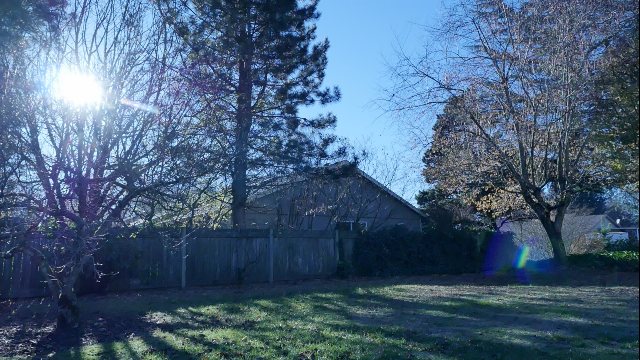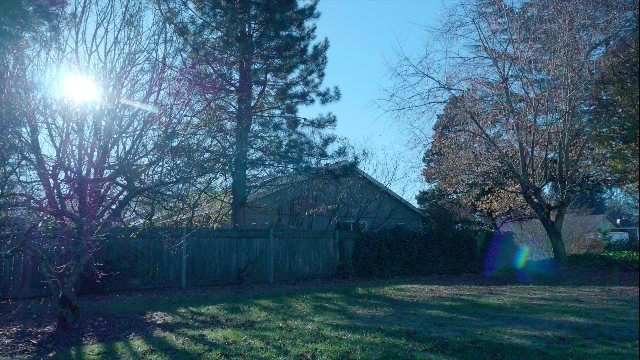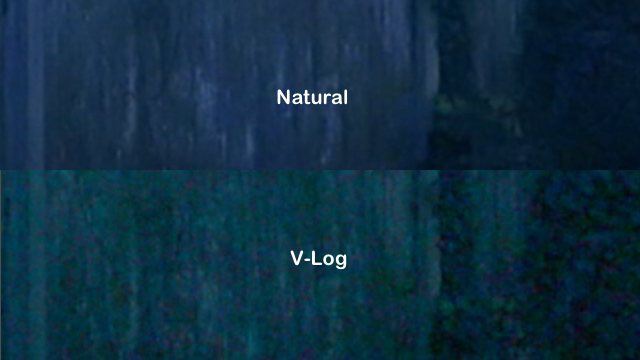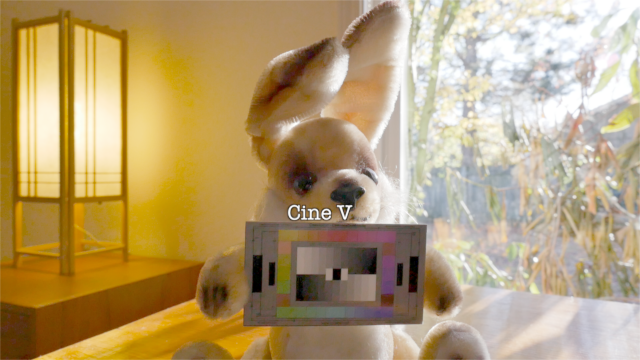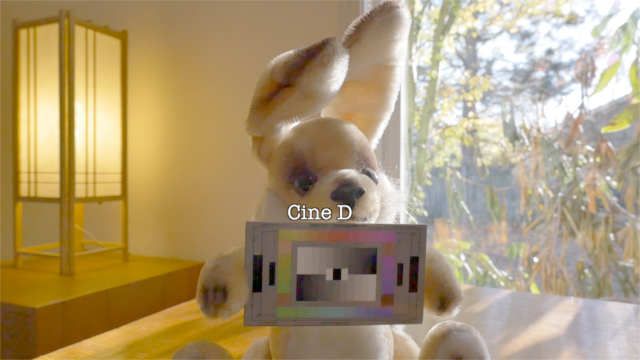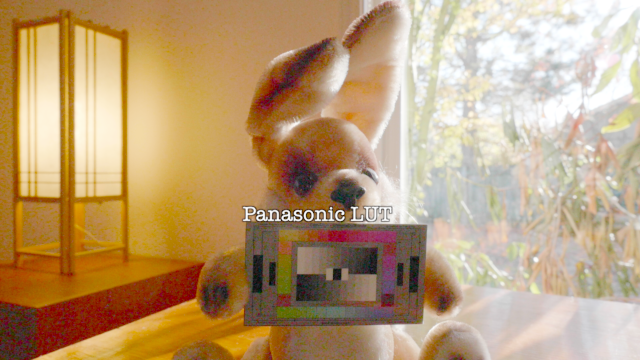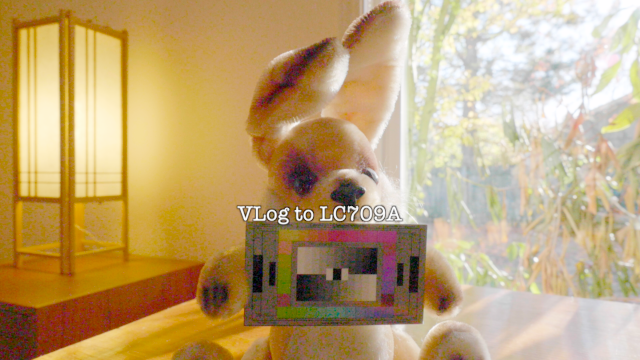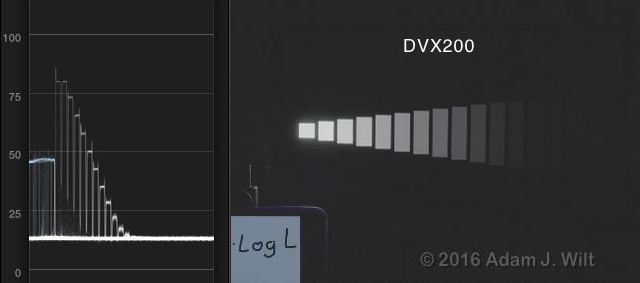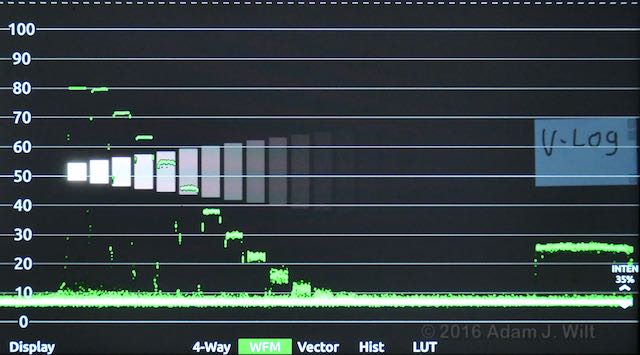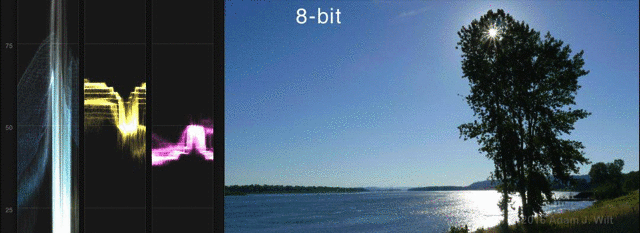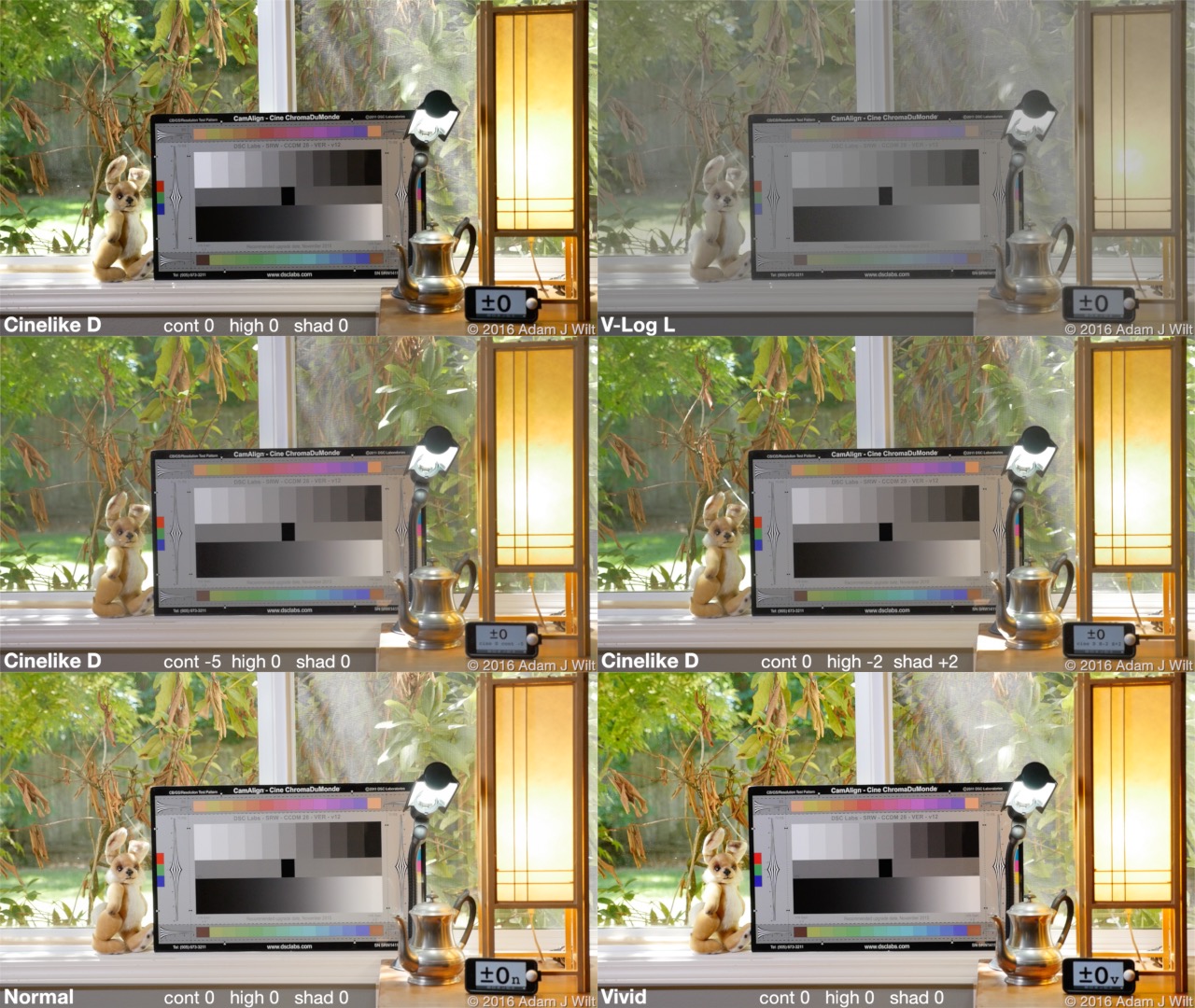In part 1 of this saga, I looked at the reasons you might want to shoot V-Log L on the GH4 (or other log formats on other cameras). In this part, I’ll discuss why you might not want to use V-Log L; look at 8-bit and 10-bit captures; and reveal some interesting aspects of how the GH4 records and outputs signals.
(Too geeky? Watch some puppy videos instead!)
When to Avoid Log
In my “Don’t Panic” article I described the main reason you might not want to record in log: you’re trying to squeeze more picture (in terms of dynamic range) into a smaller set of code values (the 7%-80% range instead of 0%-100%). In my testing I found that the GH4’s log images, graded back to “normal”, were slightly noisier than gamma-encoded images (in both luma noise in the shadows and a bit more green/magenta noise in various parts of the image), but that, for the most part, it was “mostly harmless” in the test cases I ran.
Still, there is a difference. You’re using fewer code values to capture a greater range of color and tone, so there’s a larger jump between tonal levels and color values, especially once images have been graded back into a more contrasty, saturated look. Subtleties of gradation are lost in the process, regardless of bit depth: a 10-bit log capture has less fineness of tonal and color rendering than a 10-bit gamma-encoded capture of the same scene.
In general, if you like the look of a gamma-encoded capture, and it captures all the tonal information you need in the scene, there’s no need to capture log. You may reduce the options available in post as far as color and exposure modifications are concerned, but (especially if you’re not in control of the grading process) this might be a good thing; after the rush into log and raw captures of the past few years, many cinematographers are coming to appreciate the value of baking in a look in the camera: it reduces the meddling that folks downstream can get away with!
There’s also the fact that a log capture requires post-processing (unless you’re enamored of the flat, low-con, milky look of log footage). Not every project has the time or the budget for grading each shot, and shooting log adds that step, even if it’s just going through the timeline or the bin and adding a LUT to every shot.
And then there’s the GH4, and its noisy log shadows.
That Danged Noise
I’ve shot a large variety of subjects over the past few months, recording both log- and gamma encoded clips of each, using both internal 8-bit and external 10-bit captures (the latter on a PIX-E5 recording ProRes 422 HQ). For the most part, I get very clean images from log: the noise is nicely controlled, the colors are good, and even the tricky gradient of the blue sky is usually well handled even with 8-bit internal recording.
But I’ve found a couple of cases that just don’t work on the GH4 recording V-Log. Here’s one of them in Natural gamma:
Here it is in V-Log:
When recorded in V-Log, regardless of internal or external recording, the shaded fence, side of the house, and shadowed areas are crawling with noise, as these 1:1 extracts show:
There’s also a patch of visible banding or posterization in the sky, and any attempt to boost saturation shows noise around and among the gently waving tree branches. The banding / posterization is lessened in the 10-bit recording, but it and the noise are still present, yet the natural-gamma 8-bit internal recording is as clean and smooth as anything recorded on the GH4 can be.
Is the detail in that scene, combined with the task of applying a log curve to the image, simply pushing the GH4’s processing beyond its comfortable limits?
Also, that nasty shot of Barney bunny with a miniature ChromaDuMonde? I tried grading the CDM chart back to a more “proper” exposure; here are the same four clips with a heavy (read: excessive) exposure correction applied, using the “midtones” slider in the FCPX color board:
Look at that noise in the V-Log shots! For all the supposed problems of trying to pull gamma-encoded data out of 8-bit shadows, those shots survived a lot better than the log shots did.
Consider again the fuzzy lower steps in the GH4’s V-Log Xyla waveform, and the abnormally noisy deep shadows. Here’s the same chart shot with both the GH4 and an AG-DVX200, Panasonic’s $4K, 4K camcorder similarly equipped with V-Log L:
The DVX200 shows much less noise on those darker steps. My guess is that the GH4’s internal processing isn’t quite up to the task of cleanly handling log-encoded shadows. V-Log L was added to the GH4 well after the camera’s initial release, and it’s arguable the GH4 was never designed to capture log in the first place (that the log upgrade costs $100 and requires ordering a printed card with an upgrade code on it — and that card was back-ordered for months — might imply that Panasonic isn’t especially eager to have you shoot log on the GH4 at all).
The upshot of all this is that what the GH4’s V-Log L giveth in highlight headroom, it taketh away in shadow noise. You don’t really get more usable dynamic range unless you’re very tolerant of noisy shadows, but you still get the tonal and color handling characteristics of log shooting.
Internal vs. External: Different Levels?
Look again at the WFMs from the GH4 and the DVX200, both shooting the Xyla. The DVX200 clips at 80%, while the GH4 clips at 75%. Aren’t these supposed to be the same curve? Wait, there’s more: here’s the HDMI signal out of the GH4 on a PIX-E5 monitor/recorder, showing whites at 80%, blacks at around 7%:
It appears that the HDMI output is mapping V-Log L into the full 0-255 range (assuming 8-bit values). The DVX200 seems to record it internally in the 16-255 range while the GH4 uses the 16-235 range for its internal recording. Thus there’s slightly more tonal-scale compression with the GH4’s internal recording than with external, even when sticking with 8 bits in both cases: internal log uses only 86% of the code values that external log does!
(The GH4 normally lets you change the recording scale between all three, but that choice is grayed out in V-Log mode, and changing it before setting the Custom style to V-Log doesn’t have any effect, at least not with version 2.3 firmware. I no longer have a DVX200 to test with, so I can’t see if its V-Log levels are adjustable. I also found that the levels shown and recorded on a Convergent Design Odyssey 7Q+ tracked internal levels very closely when I turned on the Odyssey’s “legalize HDMI” setting, which maps a 0-255 input to the 16-235 legal range.)
8-bit vs 10-bit: Banding
Here’s the problem with 8-bit recording using the limited bit depth of V-Log L:
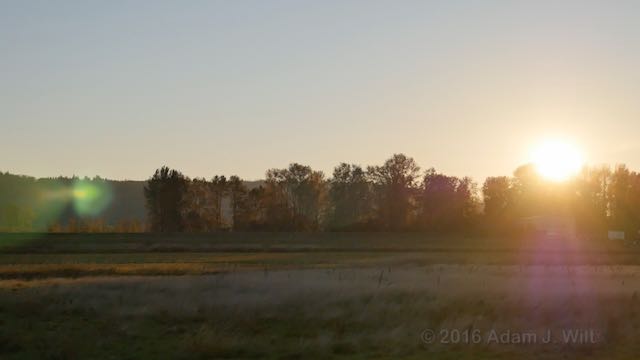
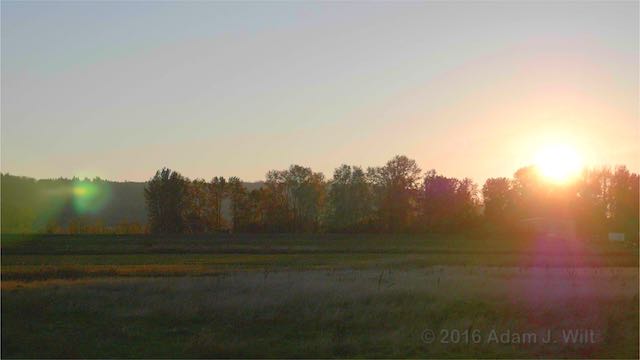
Smooth, gentle gradients like an unclouded sky can be problematic for 8-bit log recordings once expanded back to a normal viewing contrast. The example above is the worst I’ve come up with, but it’s not unusual to see this sort of thing in sky shots. Here are two examples of 8-bit internal, 8-bit external, and 10-bit external versions of the same scene. For all of ’em, click or tap the image to see a larger version, and look at the ‘scopes as well as the picture; compare the coarseness of the ‘scope traces. First, a lightly-graded wide shot:
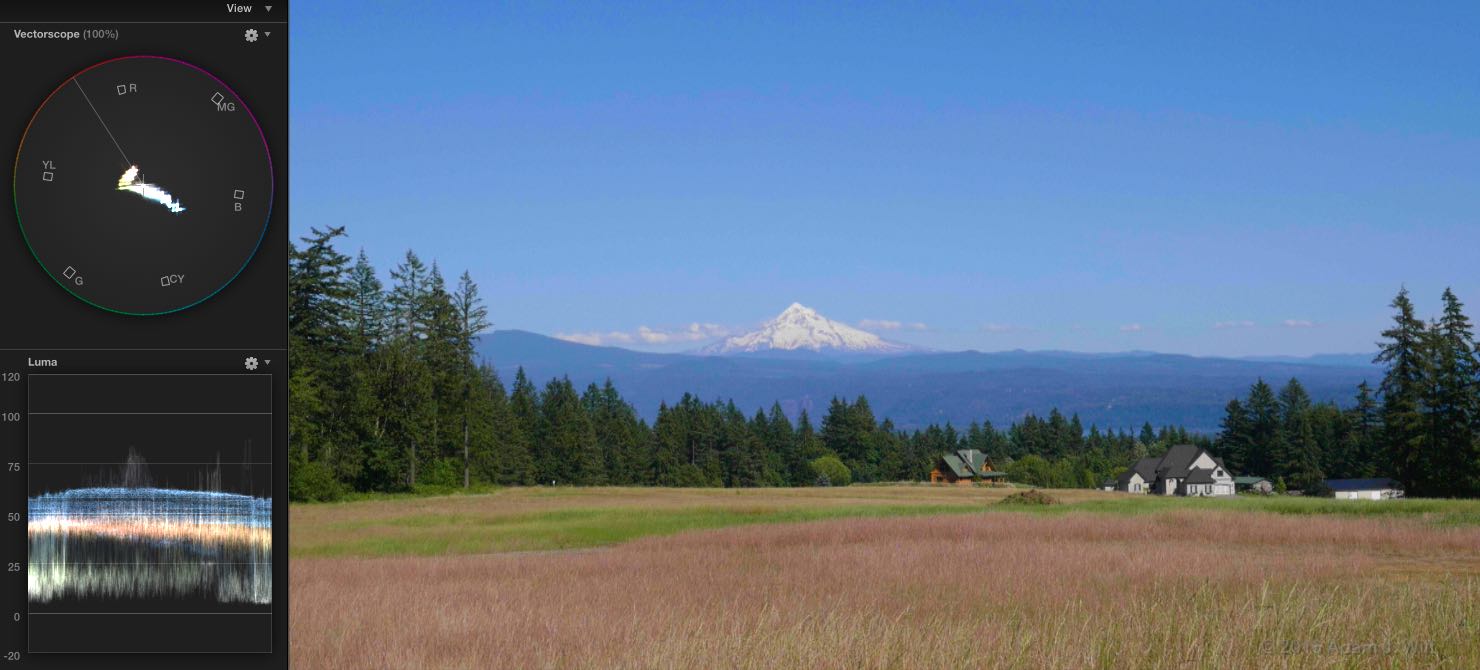
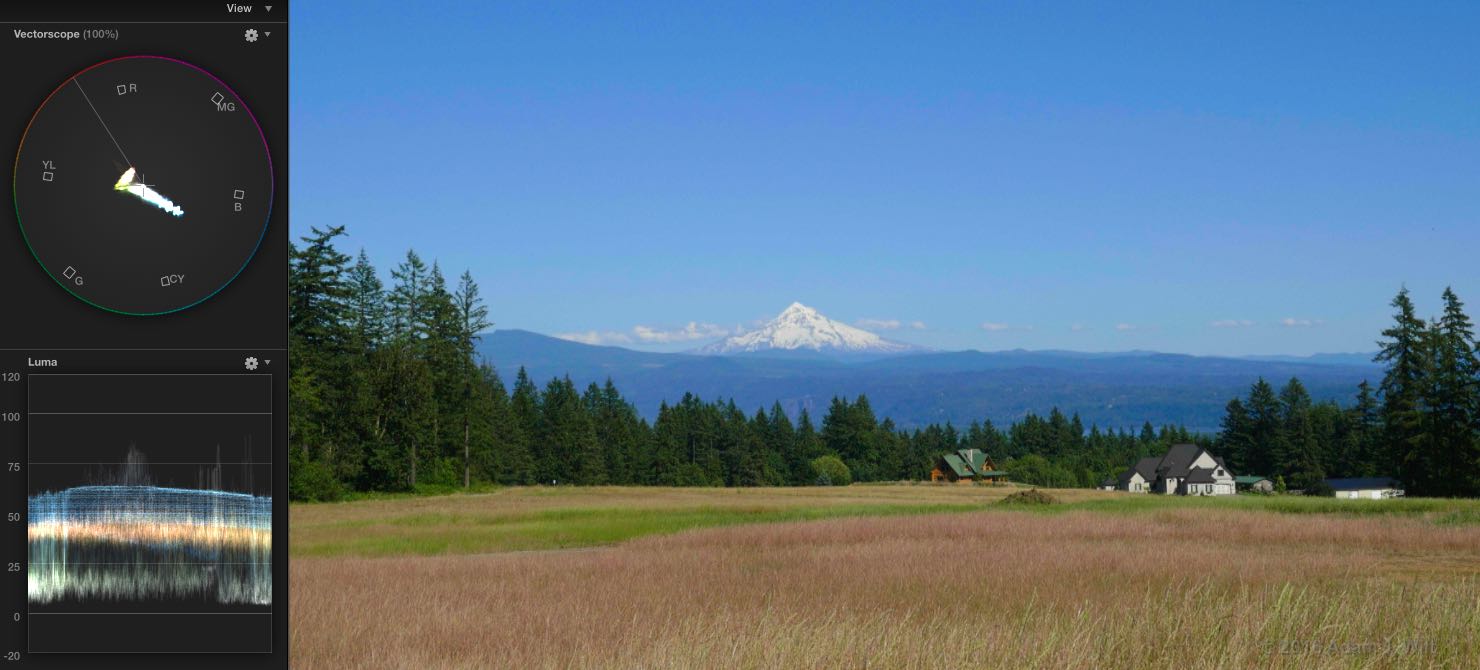
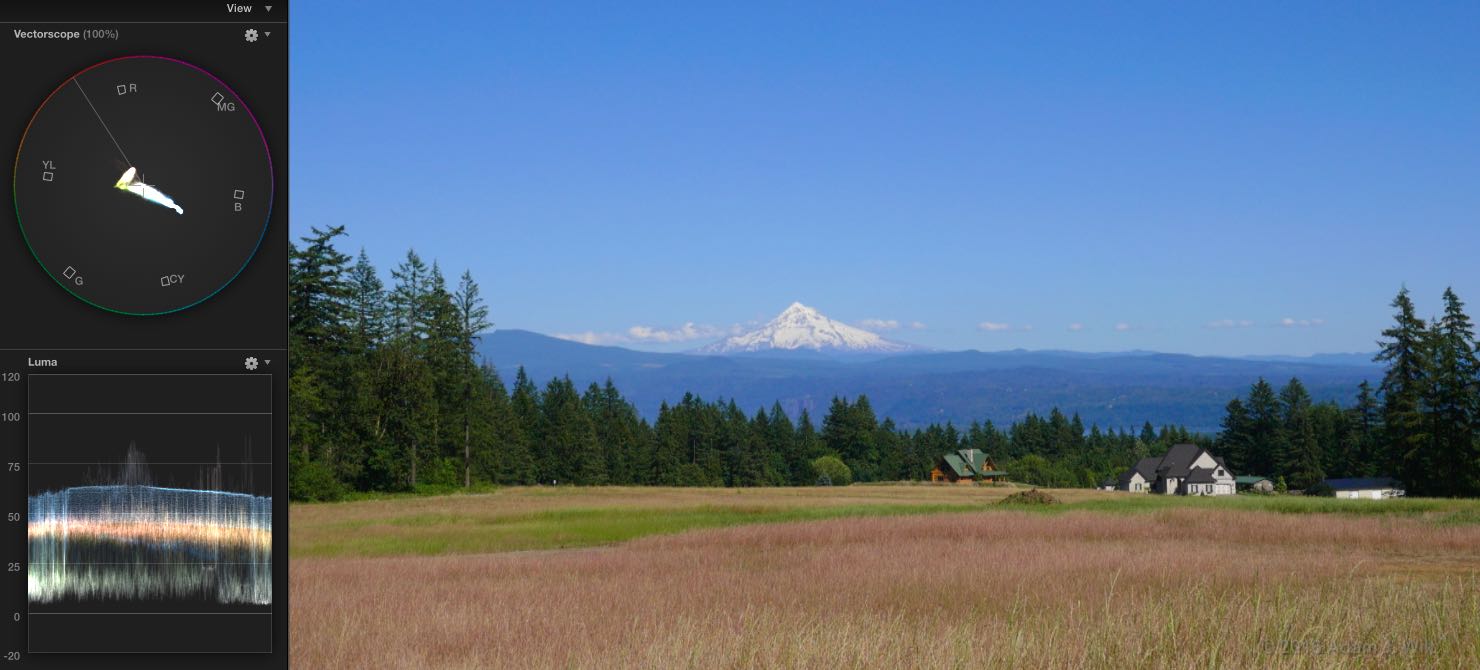
Now a very heavily graded closeup (sorry, I bumped the zoom between internal and external recordings):
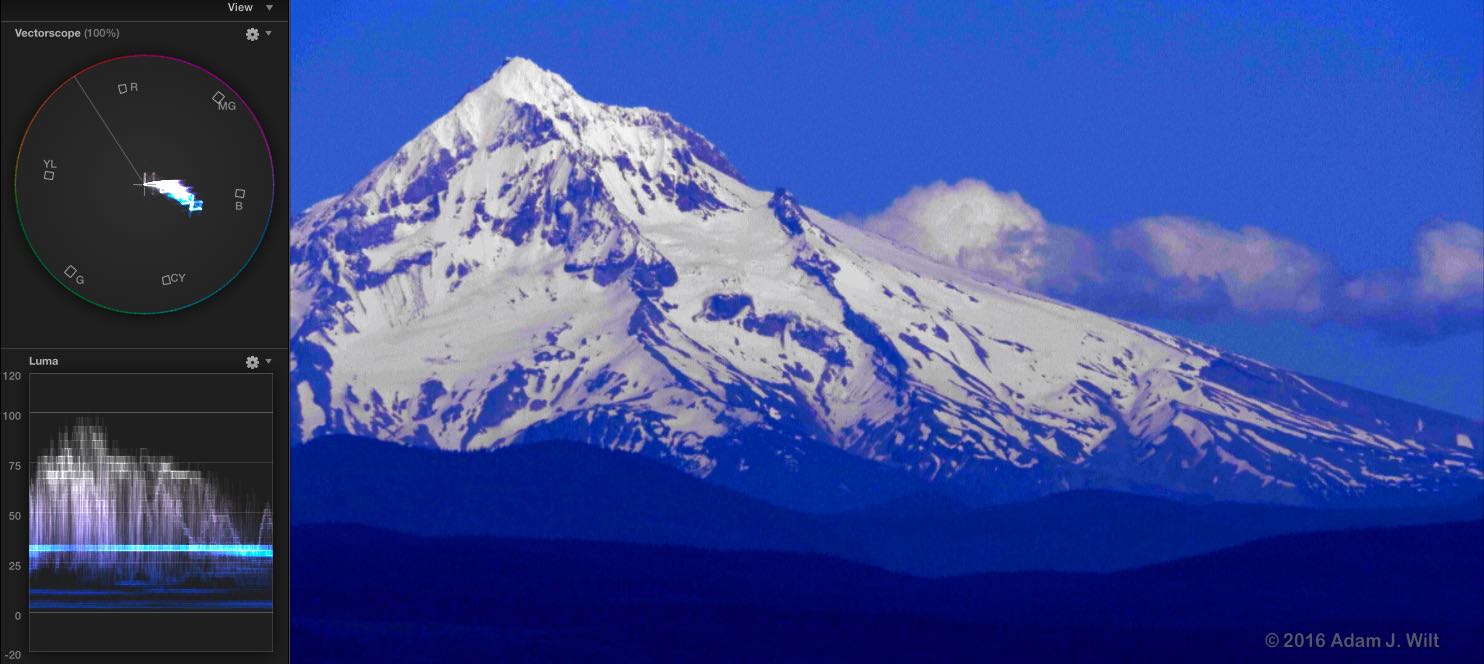
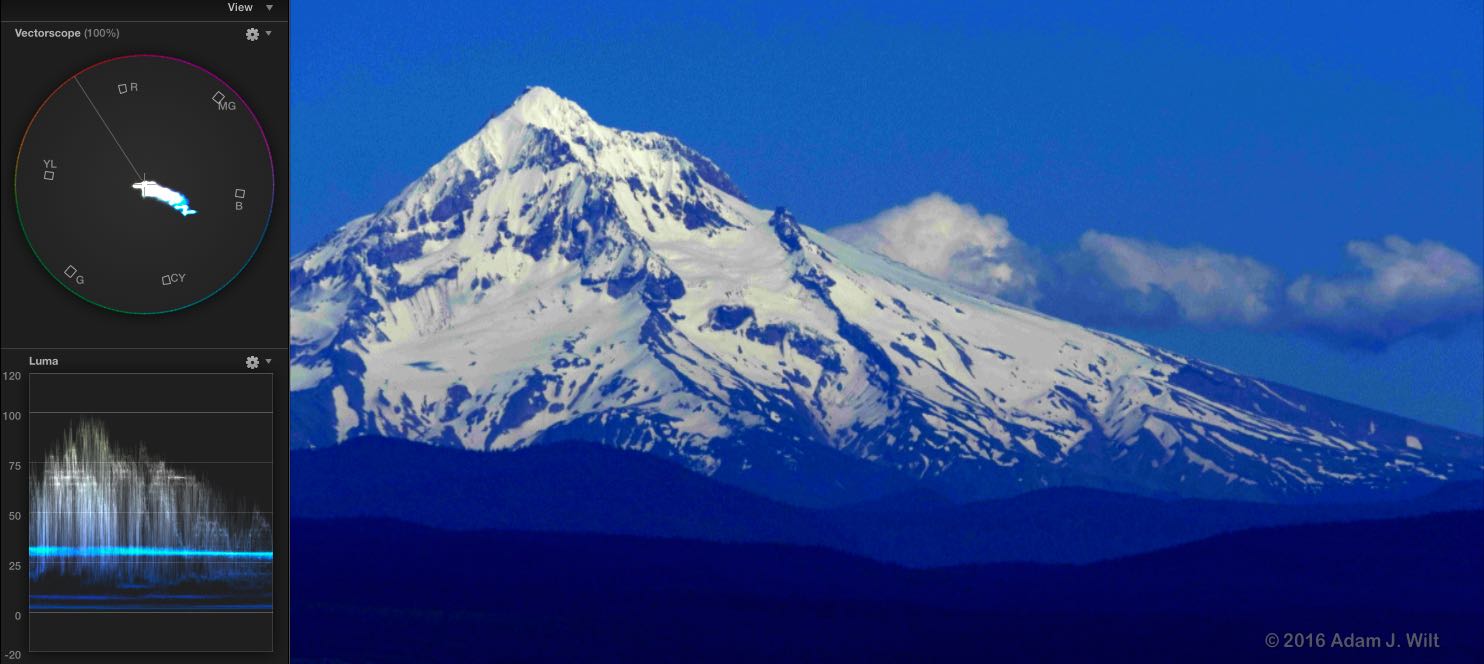
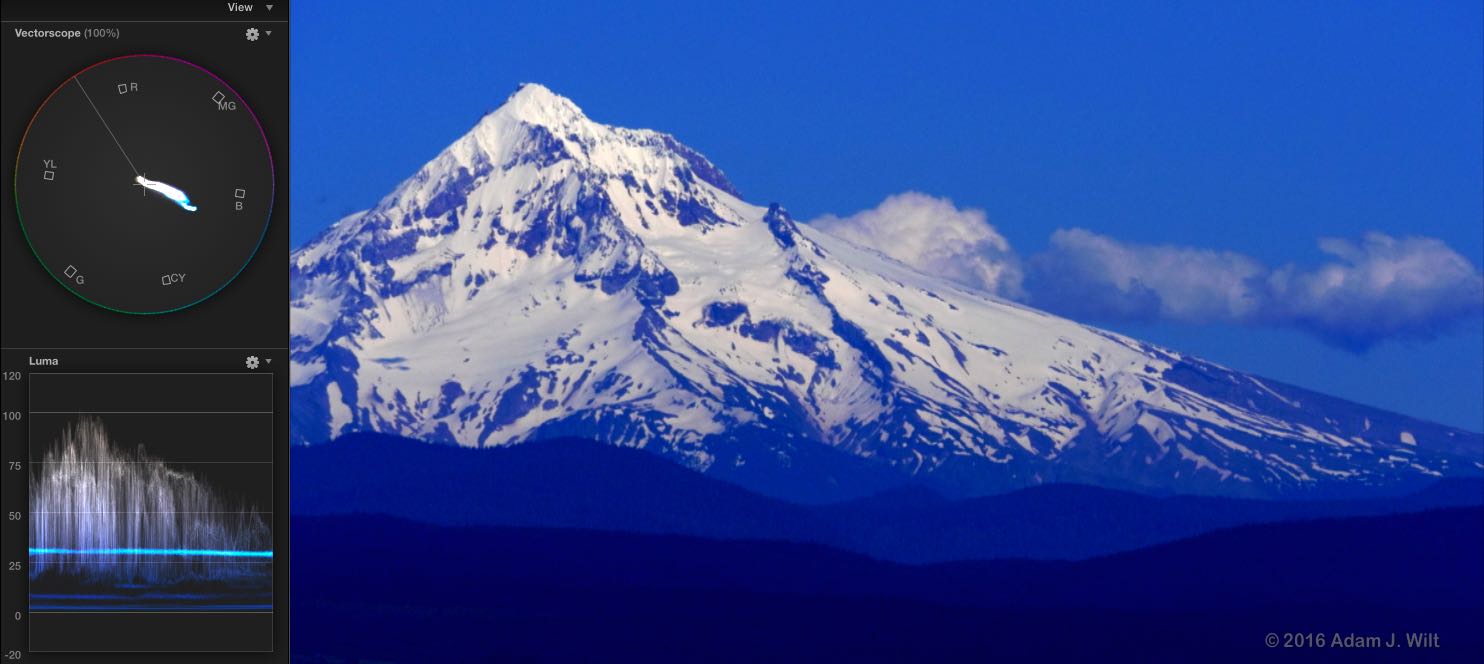
These external recordings were done with Video Devices PIX-E5 and Convergent Design Odyssey 7Q+ recorders capturing to ProRes 422, but any external recorder would show the same thing. For each shot, the same base grade was applied to all three versions, then the internal clip was tweaked a bit due to its reduced-range recording as discussed above.
(Yes, there’s still some banding in the 10-bit skies if you look closely: these are 8-bit screen grabs off an 8-bit display. You probably wouldn’t see any banding if you played the 10-bit clips on a 10-bit display using a 10-bit connection, but outside of a digital cinema or away from a professional monitor you aren’t likely to be 10 bits all the way to your viewers’eyeballs. The takeaway isn’t that you’re doomed to always see banding on an 8-bit display — though you probably are, by the way — but that the banding is greatly reduced if your source material is 10-bit to begin with.)
To be fair, these are all worst-case scenarios. Aside from a cloudless sky, it’s rare to find subject matter featureless enough, large enough, and smoothly varying enough for banding to be a seriously visible problem. I’ve tried to invoke it by shooting pools of light on walls and floors, but even a slight surface texture is enough to mask it. And there are plenty of times where sky shots don’t show noticeable banding artifacts; the GH4’s inherent noise helps dither away the problem, and many sky shots lack the unfortunate combinations of brightness and color that make banding apparent. I have several colleagues who shoot internally recorded 8-bit log, day in and day out, who never run into the issue.
Still, if you’re shooting in the great outdoors and aren’t recording 10-bit, it’s wise to eschew V-Log L for the wide shots, or at least shoot a safety using a different gamma setting.
Look again at the closeups, and note the difference in the delicacy of the clouds. The 8-bit clips show a more brutal, posterized rendition, while the 10-bit clip preserves finer gradations in their color and tone. Yes, it’s more noticeable because the contrast and saturation of the shots have been substantially increased, but it makes you wonder what you’re missing even in more conservatively-graded 8-bit images.
8-bit vs 10-bit: Level Shifts?
Another thing about that heavily graded closeup of Mt Hood: the 8-bit external clip goes a bit green in the shaded snowfields. Turns out all the 8-bit external clips are slightly greenish; it looks like the Cb and Cr color-difference signal have slight downward shifts compared to their 10-bit versions (on the vectorscope, this shows up as a shift towards the lower left quadrant, towards green):
That’s an animated GIF with only 256 colors, so yeah, you’ll see plenty of banding and dithering even in the 10-bit picture. Focus on the Y,Cb,Cr ‘scopes.
It may simply be the case that the GH4’s 8-bit output math truncates the components instead of rounding them. Oddly, 8-bit internal clips don’t show the same downward shift; there’s something different happening for internal recording, possibly related to the different internal scaling used for the Y signal.
This happens in all gammas, not just V-Log L, but the large saturation boost applied to the signal during grading accentuates the differences in log-encoded Cb and Cr color components the most. True, color correctors don’t typically have direct Cb and Cr offset adjustments; just be aware that you’ll see slight greenward color shifts in 8-bit external clips that you’ll need to pull back towards magenta ever so slightly in the grade.
Conclusions
When one sets out to write an article on a new feature, there’s always the lurking hope for a big, clickbaity conclusion: “this new X will change the way you shoot forever!” The GH4’s V-Log L isn’t like that; the case for using it is more complex. Of course, expecting a log add-on for a low-cost stills-plus-video camera to radically change the world might be a bit much in the first place.
Yes, V-Log L brings the neutral tonal-scale advantages of log to the GH4, along with a very different color rendition. Log lets the GH4 capture an additional stop or two of highlight detail, too. However, the GH4’s modest processing horsepower is stressed by the task of recording a pristine log signal, so what you gain in the highlights you lose in noisy shadows. V-Log L serves as another paint on the GH4’s palette, but it doesn’t reinvent painting entirely.
The 8-bit vs. 10-bit tests show pretty much what we would expect: 10-bit has four times the fineness of 8-bit, which can be quite helpful when a heavy grade is applied, and having a higher bit depth allows a more subtle and nuanced image rendering. But the tests also revealed a level shift in 8-bit externally-recorded Cb and Cr color components that might not have been obvious otherwise. Practically speaking, that means that external 8-bit monitoring and recording will be slightly greener than internal 8-bit recording — if you’re recording internally while monitoring externally, what you see isn’t quite what you’ll get.
It’s also interesting to see that, at least with firmware version 2.3, internal V-Log recording is mapped to the 16-235 range instead of spanning the 0-255 range as used by the outputs. From a practical standpoint this doesn’t cause a huge quality hit, but it does complicate grading internally-recorded clips alongside those from a DVX200 or Varicam, or from GH4 external recordings.
If it sounds like I’m being negative, I’m not. Expecting Varicam-level quality for under 1/15th the cost of a Varicam isn’t realistic. The GH4 does a superb job for a camera that can now be had for under $900, but a DVX200 will outperform it and a Varicam even more so. As always, you get what you pay for.
But that brings us ’round to the question: is V-Log L worth paying $100 for, all by itself? I can’t answer that; only you can say if you think V-Log adds enough value to your style of production to justify the cost.
See for Yourself
If you’re still unsure, I have a set of sample clips you can play with in your NLE / color corrector of choice. Exposures run from five stops under to five stops over, recorded internally with a variety of settings:
Want it? Download it from Dropbox (254 MB; H.264 in a .mov wrapper).
Notes:
- The “Normal” test is using “Natural” gamma.
- There’s flickering in the bulbs for the underexposed clips since I used high shutter speeds to get the underexposure.
- Except as noted on the tests, all Picture Styles are set at defaults, but Sharpness and NR are both at -5 (minimum). Clips were recorded in FHD 1920×1080.
Disclosure: I bought my GH4s with my own money at market prices. I had a DVX200 sent from Panasonic for review; it’s long since been returned. DSC Labs charts have been purchased or provided to me on long-term loans. The Odyssey 7Q+ and PIX-E5 recorders are on loan from their manufacturers for software development and beta-testing. I worked for Video Devices to develop the UI and ‘scopes for the PIX-Es and I’ve worked for DSC Labs at trade shows; aside from that there is no material relationship between me and any of the vendors mentioned.

Filmtools
Filmmakers go-to destination for pre-production, production & post production equipment!
Shop Now